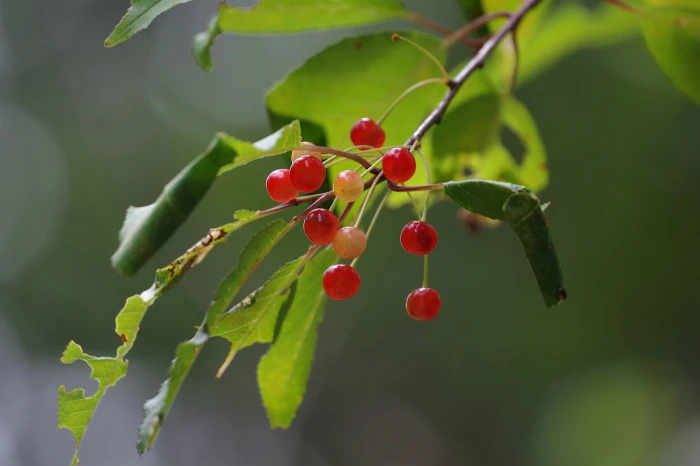Pin Cherry
(Prunus pensylvanica)
Pin Cherry (Prunus pensylvanica)
/
/

Sajith Sasidharan
CC BY 4.0




















































Estimated Native Range
Climate Requirements for Clinton, Maryland
| This Plant | Your Site | Plant Suitability for Your Location | ||
|---|---|---|---|---|
| • Precipitation | 10" - 83" | 42" | Aquatic | Aquatic |
| • High Temp. | 64°F - 95°F | 87°F | Your summer temperatures are normal for this plant. | Excellent |
| • Low Temp. | -27°F - 32°F | 25°F | Your winter temperatures are normal for this plant | Excellent |
Summary
Pin Cherry’s flowers are small, white, and appear in clusters of five to seven in late spring, offering a modest display. The fruit is a small red drupe that matures in late summer, providing food for wildlife and opportunities for human culinary use. The tree is valued for its ability to thrive in disturbed sites, making it useful for reclamation projects. It is also used ornamentally in naturalized areas or as a pioneer species in forest restoration. Pin Cherry prefers well-drained soils and is adaptable to full sun or partial shade conditions. While it is not typically prone to serious pest or disease problems, it can suffer from cherry leaf spot and is relatively short-lived, often succumbing to disease or competition after 20-40 years.CC BY-SA 4.0
Plant Description
- Plant Type: Tree, Shrub
- Height: 25-30 feet
- Width: 15-30 feet
- Growth Rate: Rapid
- Flower Color: White
- Flowering Season: Spring
- Leaf Retention: Deciduous
Growth Requirements
- Sun: Full Sun, Part Shade
- Water: Medium
- Drainage: Fast
Common Uses
Bee Garden, Bird Garden, Butterfly Garden, Edible*Disclaimer: Easyscape's listed plant edibility is for informational use. Always verify the safety and proper identification of any plant before consumption., Erosion Control, Fire Resistant, Fragrant, Rabbit Resistant, Showy Flowers
Natural Habitat
native to cool temperate regions, including boreal forests and the edges of wetlands in the Northeastern United States and Canada, as well as montane regions in parts of the Rocky Mountains
Other Names
Common Names: Bird Cherry, Red Cherry, Fire Cherry, Feuerkirsche, Amerikanskt Häggkörsbär, Amerikansk Körsbärshägg
Scientific Names: Prunus pensylvanica, Cerasus pensylvanica, Prunus pensylvanica var. pensylvanica, Cerasus persicifolia, Padellus pennsylvanica, Padus pensylvanica, Prunus borealis, Prunus persicifolia, Cerasus borealis
GBIF Accepted Name: Prunus pensylvanica L.fil.